
Product test
49 inches are perfect for the office
by Kevin Hofer

Finally, gamers will get the cinematic experience they deserve. Samsung is releasing the first ever gaming monitor in 32:9 format, with 5120 × 1440 resolution and 120 Hz of delightful eye-pleasing frequency. They aim to bring you even closer to the action, creating a new way of looking at gaming.
Wow is this thing curvy. And that’s a compliment. Possessing a screen curvature of 1800 R, Samsung’s LC49RG90 is even curvier than Dell’s 49-inch, 3800 R monitor I recently tested. Thanks to this, I can see everything even better now. I like this.
Here’s what the monitor offers:
The Samsung monitor takes up a large part of my desk. With a 180 × 80 centimetre workspace, I do have access to a relatively large area. The monitor still catches the eye as well as the jealous looks of passers-by. Rightly so, as the screen does pack quite a punch.
Aside from its imposing stature, the LC49RG90 – for simplicity’s sake, I’ll refer to it as «Curvy» from now on – doesn’t seem like a gaming monitor from its looks alone. Two arched stabilisers spread out symmetrically from the synthetic base. The slim frame – two millimetres left and right, three millimetres on top and 20 millimetres on the bottom – boasts a brushed aluminium style. Aside from that, the monitor doesn’t appear remarkable. I like this.

By the way, the assembling process is much less IKEA-inspired than its competitor from Dell. The base is quickly attached, making an instruction manual unnecessary. Samsung offers these connection ports:
No USB-C or upstream ports are present.
Samsung allows its gigantic monitor just four buttons. Three of those are speed buttons for game settings. Everything else is controlled by the power joystick. One press accesses the five-point main menu: submenu, input signal, picture-by-picture, turn off monitor and close main menu.
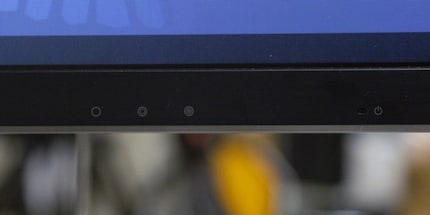
The submenu offers the requisite settings Game, Picture, Display and System. I personally dislike that I can only access these settings after passing through one menu layer.
What’s better is that you can control the attached headphones’ volume by pressing right and left on the joystick. If you press the joystick away from you, you can access the picture settings. Pull it towards you and you turn the eye strain-relieving mode on and off.
I’ve been using «Curvy» as my office monitor for the last few days and I enjoy working with it a lot. Thanks to the increased curvature, I can view the display better than with the Dell monitor. The only drawback: my work notebook doesn’t have enough power to achieve a resolution higher than 3840 × 1080. Due to this, the image isn’t perfectly sharp. If you want to use its resolution to all its glory, you’ll need a dedicated graphics card.
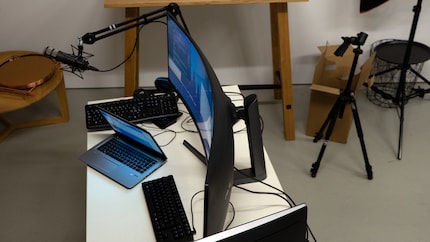
Samsung added a VA panel to «Curvy». This displays blacks darker than IPS panels, creating better contrast. Otherwise, the two panels are more or less the same. A downside comes from the longer response time you get than with TN panels. Newer VA panels have override functions, however, allowing for quicker response times necessary when gaming – around 4 ms (grey to grey).
To enjoy the monitor at its fullest potential, I had to lug it into our studio and attach it to our dedicated gaming PC. Neither my work notebook nor the Asus Scar II gaming notebook fulfil the hardware requirements needed to use «Curvy» in full resolution at 120 Hz. The highest either will go is 3840 × 1080 or 120 Hz, the data throughputs of HDMI and Mini-DisplayPort don’t allow for more.
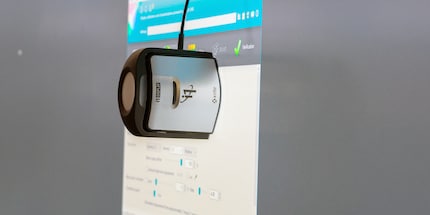
Sitting at the gaming PC, even my Google Docs look a bit prettier, and I get to work measuring the actual values. First and foremost: all the data I collected was lower than that specified by Samsung across the board. This could be attributed to me having received a pre-production sample to test out. I performed the measurements using X-Rite’s i1 Display Pro. Using DisplayCal, I measured the following values for colour space coverage:
The differences between the stated and measured values were 17 (DCI P3) and 27 (sRGB) percent respectively. I’m used to actual measurements not corresponding to indicated ones when it comes to monitors. A difference this large is still glaring, however. Hopefully Samsung will be able to get their act together when the definitive model releases.
The tested brightness levels also fall well short of my expectations. On the highest setting, I measured between 582 and 669 Nits. These values are more than a third under the expected levels. At the same time, the panel isn’t equally brightened. This is noteworthy with «Curvy», as I measured the 669 Nits in the middle and the 582 Nits just below that. The brightness towards the bottom end of the screen noticeably fades when displaying a white screen. Additionally, the HDR 1000 certification falls into question with the measured values.
The static contrast ratio is 2845:1; the dynamic one 8577:1. At least «Curvy» only missed the 3000:1 target by 5 percent.
Finally, after completing my tests, I got to game on «Curvy». I started up «Deus Ex: Mankind Divided». As soon as the game starts up, reality sucker punches me. All the resolution in the world wouldn’t save me from two massive black bars left and right. I combed through all settings, even Windows display and the Nvidia control panel. Everything seems in order. I started the game anew. Black bars. Again. What was going on?
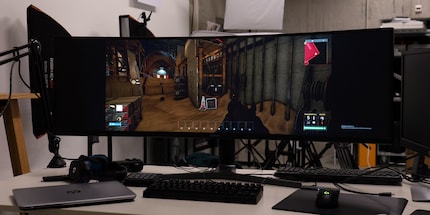
I tried «Metro: Exodus». Phew, it worked here, no black bars to be seen. «Deus Ex: Mankind Divided» doesn’t seem to be able to display a 32:9 format properly. «Metro: Exodus» is a real blast in 32:9. I felt like I was getting even more immersed in the events as they were happening. The field of view is much wider and the image looks insanely good. It’s sharp as a knife, fast movements don’t leave any streaks and screen tearing isn’t an issue. I couldn’t notice any differences in response time to other gaming monitors either.
I ended on «Anthem», the other game we had installed on our gaming PC. I enjoyed the environment and thanks to HDR support, the colours really popped. Obviously, I immediately compared the game with HDR on and off.
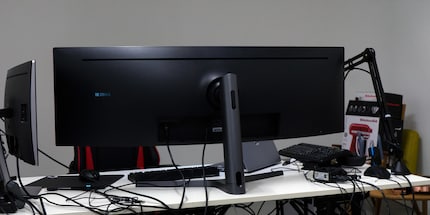
Personally, I find the HDR enabled colours too exaggerated. Dark areas, on the other hand, are displayed more beautifully. It’s a shame that «Anthem» doesn’t offer any option to adjust HDR and reduce a bit of colour intensity. A mix of HDR on and off would suit my tastes perfectly.
«Curvy» makes an impression whether in the office or gaming. I’ll miss him after I give him back. I have everything I need at a glance and am more efficient when I work, as I don’t get neck pains. I get immersed into games more. The image satisfies at both applications.

However, I still need to criticise the display quality. Not subjectively – I personally enjoyed the image a lot. But missing the promised colour space coverage by that much, even in pre-production, is disappointing. With a 77 percent DCI-P3 colour space coverage, an important factor for gamers, the monitor still reaches a solid level. It still has a way to go until it reaches the promised 95 percent, however. Hopefully Samsung fixes this before production starts.
When it comes to connectivity, it’s a shame that USB-C and upstream ports aren’t supported. Many users would be very interested in this, and at «Curvy’s» price point, this should be standard. At over 1,700 francs, this monitor definitely isn’t cheap.
If I had the money and needed a new screen, I would seriously think long and hard about getting «Curvy». But I’d wait until the first series of tests on the production model are performed. Of course Samsung can cite their own figures, but the differences in this case are still (too) big. I’ll definitely get the release version and will post my results in an update to this article.
From big data to big brother, Cyborgs to Sci-Fi. All aspects of technology and society fascinate me.